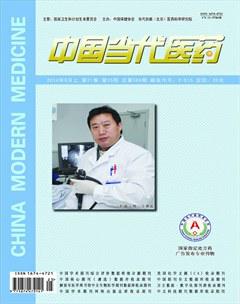胃蛋白酶原Ⅰ联合胃泌素—17检测对慢性萎缩性胃炎发病部位及胃癌进展时期的预测价值
2014-10-23周海平
周海平
[摘要] 目的 探讨胃蛋白酶原Ⅰ(PGⅠ)联合胃泌素-17(G-17)检测对慢性萎缩性胃炎发病部位及胃癌进展时期的预测价值。 方法 选择本院收治的慢性萎缩性胃炎患者33例、胃癌患者35例作为研究对象,进行PGⅠ、PGⅡ和G-17检测,比较并分析PGⅠ、PGⅡ及G-17水平的变化情况。 结果 慢性萎缩性胃炎组PGⅠ和G-17水平高于胃癌组,差异有统计学意义(P<0.05),胃窦部组的PGⅠ水平高于胃体部组和全胃弥漫组,差异有统计学意义(P<0.05),胃体部组的G-17水平高于全胃弥漫组和胃窦部组,差异有统计学意义(P<0.05),早期胃癌或原位癌的PGⅠ和G-17水平显著高于进展期胃癌,差异有统计学意义(P<0.05)。 结论 胃窦部发病为主的慢性萎缩性胃炎其G-17显著下降,胃体部或全胃病变者PGⅠ的下降更加明显,进展期胃癌者PGⅠ水平更低而G-17水平更高。
[关键词] 胃蛋白酶原Ⅰ;胃泌素-17;预测;慢性萎缩性胃炎部位;胃癌进展
[中图分类号] R446.11+9 [文献标识码] A [文章编号] 1674-4721(2014)09(a)-0126-03
The prediction vaule of pepsinogenⅠ combined with gastrin-17 in lesion location of chronic atrophic gastritis and the period of gastric cancer progression
ZHOU Hai-ping
Department of Elderly Cadre,People′s Hospital of Yichun City in Jiangxi Province,Yichun 336000,China
[Abstract] Objective To investigate the prediction vaule of pepsinogenⅠ combined with gastrin-17 in lesion location of chronic atrophic gastritis and the period of gastric cancer progression. Methods 33 cases with chronic atrophic gastritis and 35 cases in the different period of gastric cancer in our hospital were selected as research objects.All these participants were detected by pegsinogenⅠ,pegsinogenⅡ and gastrin-17.The level of pegsinogenⅠ,pegsinogenⅡ and gastrin -17 were compared and analyzed. Results The level of pepsinogens I and gastrin-17 in chronic atrophic gastritis group were higher than that in gastric cancer group,with statistical difference(P<0.05).Pepsinogen I level in the gastric antrum of chronic atrophic gastritis was higher than that in the gastric body and the total diffuse,with statistical difference(P<0.05),the gastrin-17 level in the gastric body was higher than that in the total diffuse and in the gastric antrum,with statistical difference(P<0.05).Pepsinogen I and gastrin-17 lever of early gastric cancer and carcinoma in situ were higher than advanced gastric carcinoma,with statistical difference(P<0.05). Conclusion The gastrin-17 in gastric antrum of chronic atrophic gastritis decreases significantly,pepsinogen I fell more sharply in the gastric body and the total diffuse,pepsinogen I level decreases significantly and the gastrin-17 level increases significantly with progression of gastric cancer.
[Key words] PepsinogenⅠ;Gastrin-17;Prediction;Lesion location of chronic atrophic gastritis;Progression of gastric carcinoma
胃蛋白酶原(pegsinogen,PG)表达异常的人群发生慢性萎缩性胃炎甚至进展为胃癌的可能性相对于正常人群显著增加,可以将其列为胃癌的高危人群,联合血清PG和胃泌素检测对于诊断临床微小胃癌甚至原位癌具有较高的敏感性和特异性,而进展期胃癌患者血清内血清PGⅠ与胃泌素-17(gastrin-17,G-17)的水平更低,高分化患者其水平低于低分化者[1-2]。其中PG联合G-17检测在慢性萎缩性胃炎以及胃癌中的价值已得到临床验证,但是其与慢性萎缩性胃炎具体发病部位及胃癌具体进展时期之间的关系尚未明确[3],本研究通过对PGⅠ与G-17的检测,探讨其在预测慢性萎缩性胃炎发病部位以及胃癌进展时期中的价值。endprint
1 资料与方法
1.1 一般资料
选择2008年1月~2012年6月本院收治的慢性萎缩性胃炎患者33例、胃癌患者35例作为研究对象,所有患者均经病理检查确诊,其中慢性萎缩性胃炎组:男18例,女15例;年龄38~76岁,平均(56.8±5.4)岁。胃癌组:男18例,女17例;年龄40~78岁,平均(58.1±6.1)岁。
1.2 方法
所有患者入院后均抽取晨起空腹静脉血4 ml,送检验室行离心处理后保持于-20℃冰箱内,其中PG测定采用胶乳增强免疫比浊法(北京九强公司提供试剂盒),标准品采用雅培公司放射免疫分析法之标准比对品,并通过罗氏公司生产的Modular P800型检测仪严格按照说明书进行PGⅠ和PGⅡ的检测;G-17的检测采用反射免疫法(北京福瑞公司提供试剂盒),通过合肥众成机电公司生产的DFM-96型放射免疫计数器,严格按照说明书进行测定。所有患者均通过胃镜检查确定病变部位和范围,并留取病理组织标本送病理检查确诊。
1.3 观察指标
比较慢性萎缩性胃炎与胃癌患者PGⅠ、PGⅡ及G-17水平,并分析慢性萎缩性胃炎患者不同发病部位和胃癌患者不同发病时期PGⅠ、PGⅡ及G-17水平的变化情况。
1.4 统计学处理
采用SPSS 13.0统计学软件对数据进行处理,计量资料以x±s表示,采用t检验,计数资料采用χ2检验,以P<0.05为差异有统计学意义。
2 结果
2.1 两组PGⅠ、PGⅡ及G-17水平的比较
慢性萎缩性胃炎组PGⅠ和G-17水平均高于胃癌组,差异有统计学意义(P<0.05),PGⅡ水平比较,差异无统计学意义(P>0.05)(表1)。
表1 两组PGⅠ、PGⅡ及G-17水平的比较(x±s)
2.2 慢性萎缩性胃炎组不同发病部位PGⅠ、PGⅡ及G-17水平的比较
胃窦部组的PGⅠ水平高于胃体部组和全胃弥漫组,差异有统计学意义(P<0.05),胃体部组的G-17水平高于全胃弥漫组和胃窦部组,差异有统计学意义(P<0.05),各部位间PGⅡ水平比较差异无统计学意义(P>0.05)(表2)。
表2 慢性萎缩性胃炎组不同发病部位PGⅠ、PGⅡ及G-17
水平的比较(x±s)
2.3 胃癌组不同发病时期PGⅠ、PGⅡ及G-17水平的比较
早期胃癌或原位癌的PGⅠ和G-17水平显著高于进展期胃癌,差异有统计学意义(P<0.05);PGⅡ水平比较,差异无统计学意义(P>0.05)(表3)。
表3 胃癌不同发病时期PGⅠ、PGⅡ及G-17水平的比较(x±s)
3 讨论
PG是人体分泌的胃蛋白酶的前体,胃黏膜中的主细胞和颈黏液细胞主要分泌PGⅠ和极少量的PGⅡ,贲门及幽门的腺体细胞则主要分泌PGⅡ,同时前列腺和胰腺也具有分泌少量PGⅡ的功能。PGⅠ和PGⅡ是两种不同免疫活性的胃蛋白酶[4],血清内不同PG的水平可以反映胃黏膜中不同部位的形态及功能,其中PGⅠ主要是检测胃泌酸细胞功能的指标,在胃酸过多的情况下,PGⅠ水平显著升高,其分泌量的减少则可能发生胃黏膜腺体的萎缩,而PGⅡ的分泌量则是反应胃底黏膜病变的相关指标[5],其升高可能与胃底腺管的萎缩及肠上皮化生甚至恶性肿瘤的发生有关,而两者的比值(PGⅠ/PGⅡ)如果出现动态性降低,则应警惕萎缩性胃炎的发生。G-17主要由消化系统的G细胞分泌,是一种重要的调节消化道功能和维持消化道结构完整的内分泌激素,超过80%的G-17为胃窦部G细胞分泌,人体中95%以上的活化胃泌素为α-酰氨胃泌素。针对PGⅠ与G-17整体变化而言,慢性萎缩性胃炎组PGⅠ和G-17水平均高于胃癌组。
在慢性萎缩性胃炎发病过程中,胃黏膜固有腺体数量减少,功能减退,导致黏膜萎缩、变薄。对小鼠的实验研究表明,在慢性萎缩性胃炎患者中,由于胃底腺的数量减少,故合并有主细胞、颈黏液细胞的减少,从而导致PGⅠ水平降低[6-7],另外由于分泌PGⅡ的细胞较多,且其分布广泛,尤其是肠腺、前列腺亦可分泌少量的PGⅡ,因此在发生慢性萎缩性胃炎时,PGⅡ的下降无明显改变。血清中PGⅠ的降低是诊断萎缩性胃体胃炎的良好指标,可以用来诊断萎缩性胃炎并提示胃癌高危,从而检出可根治的早期胃癌[8]。本研究显示,慢性萎缩性胃炎发病部位在胃窦部者PGⅠ水平高于胃体部者和全胃弥漫者,G-17水平中胃体部者高于全胃弥漫者和胃窦部者,慢性萎缩性胃炎胃镜检查可以发现其病灶主要呈灶性分布,且病变多发生于胃小弯侧,并逐渐扩散而波及胃窦甚至胃体部,存在缓慢融合的趋势,而且随着病变的进展,胃部正常腺体分泌功能受到的影响逐渐加大甚至丧失分泌功能,同时酶的合成与分泌功能亦会受到波及[9]。病变部位在胃窦时,其内腺体丧失导致G细胞数量减少,进入血液循环的G-17水平降低;胃体萎缩时,胃酸分泌降低,对胃窦G细胞的抑制作用减弱,导致G-17分泌增加,血清G-17水平升高。
慢性萎缩性胃炎被认为是胃癌的过渡病变,慢性萎缩性胃炎-肠化生-不典型增生-胃癌是常见的肠型胃癌发生的4个阶段[10-11]。血清PG检测在早期胃癌筛查方面优于X线双对比造影,国外研究建议将PGⅠ<70 ng/ml、PGⅠ/PGⅡ<3.0定为拟诊断临界值,尤其是对于具有显著临床表现的肠型胃癌,以及病灶小且位于贲门和胃前壁、放射性检查方法较易漏诊的肿瘤效果更佳。血清G-17检测是近年来兴起的应用于筛查早期胃癌的指标之一,联合PG检查,当PGⅠ<45 ng/ml、G-17>60 pg/ml时,为拟诊断临界值。本研究显示,早期胃癌或原位癌的PGⅠ和G-17水平显著高于进展期胃癌;胃窦部发病为主的慢性萎缩性胃炎其G-17显著下降,PGⅠ下降不明显,而胃体部或全胃病变者PGⅠ下降程度更加显著;胃癌患者中,进展期胃癌者PGⅠ水平更低而G-17水平更高。endprint
[参考文献]
[1] Ghoshal UC,Kumar S,Krishnani N,et al.Serological assessment of gastric intestinal metaplasia and atrophy using pepsinogen-Ⅰ,pepsinogen-Ⅱ and gastrin-17 levels in a low incidence area of gastric cancer endemic for H.pylori infection[J].Trop Gastroenterol,2011,32(4):292-298.
[2] Nasrollahzadeh D,Aghcheli K,Sotoudeh M,et al.Accuracy and cut-off values of pepsinogensⅠ,Ⅱ and gastrin 17 for diagnosis of gastric fundic atrophy:influence of gastritis[J].PLoS One,2011,6(10):e26957.
[3] Colarossi A,Inga R,Prochazka R,et al.Pepsinogen and gastrin in the noninvasive diagnosis of gastric atrophy.A case-control study in Peruvian population[J].Rev Gastroenterol Peru,2011,31(2):110-115.
[4] 付华.血清胃蛋白酶原以及胃泌素-17与慢性胃炎[J].贵阳医学院学报,2011,36(2):187-189.
[5] 曹勤,冉志华,萧树东.检测血清胃蛋白酶原和胃泌素-17诊断胃癌的临床价值[J].胃肠病学和肝病学杂志,2007, 16(4):361-364.
[6] 马颖杰,王惠吉.血清胃蛋白酶原、胃泌素-17与慢性萎缩性胃炎[J].胃肠病学,2007,12(7):422-424.
[7] 黄蔚,蔡美珠,吴瑶,等.血清胃蛋白酶原和胃泌素-17联合检测在老年胃癌及萎缩性胃炎中的临床意义[J].中国医药指南,2008,6(4):134-136.
[8] 杨俊,厉朝喜,戴一扬,等.三叶因子1蛋白与血清胃蛋白酶原在胃溃疡中的表达及其意义[J].中华医学杂志,2012,92(22):1540-1543.
[9] 易楠,王珏,王江红.血清胃蛋白酶原在胃癌及胃癌前病变诊断中的意义[J].重庆医学,2011,40(27):2722-2723.
[10] 高海燕,于秀艳,汪杰.血清胃蛋白酶原(PGⅠ)测定对胃癌的诊断意义[J].中国实验诊断学,2009,13(9):1250.
[11] 杨勤,姚玉玲.胃蛋白酶原与胃泌素检测对慢性萎缩性胃炎的诊断价值探讨[J].实用临床医药杂志,2012,16(23):23-24,31.
(收稿日期:2014-07-17 本文编辑:祁海文)endprint
[参考文献]
[1] Ghoshal UC,Kumar S,Krishnani N,et al.Serological assessment of gastric intestinal metaplasia and atrophy using pepsinogen-Ⅰ,pepsinogen-Ⅱ and gastrin-17 levels in a low incidence area of gastric cancer endemic for H.pylori infection[J].Trop Gastroenterol,2011,32(4):292-298.
[2] Nasrollahzadeh D,Aghcheli K,Sotoudeh M,et al.Accuracy and cut-off values of pepsinogensⅠ,Ⅱ and gastrin 17 for diagnosis of gastric fundic atrophy:influence of gastritis[J].PLoS One,2011,6(10):e26957.
[3] Colarossi A,Inga R,Prochazka R,et al.Pepsinogen and gastrin in the noninvasive diagnosis of gastric atrophy.A case-control study in Peruvian population[J].Rev Gastroenterol Peru,2011,31(2):110-115.
[4] 付华.血清胃蛋白酶原以及胃泌素-17与慢性胃炎[J].贵阳医学院学报,2011,36(2):187-189.
[5] 曹勤,冉志华,萧树东.检测血清胃蛋白酶原和胃泌素-17诊断胃癌的临床价值[J].胃肠病学和肝病学杂志,2007, 16(4):361-364.
[6] 马颖杰,王惠吉.血清胃蛋白酶原、胃泌素-17与慢性萎缩性胃炎[J].胃肠病学,2007,12(7):422-424.
[7] 黄蔚,蔡美珠,吴瑶,等.血清胃蛋白酶原和胃泌素-17联合检测在老年胃癌及萎缩性胃炎中的临床意义[J].中国医药指南,2008,6(4):134-136.
[8] 杨俊,厉朝喜,戴一扬,等.三叶因子1蛋白与血清胃蛋白酶原在胃溃疡中的表达及其意义[J].中华医学杂志,2012,92(22):1540-1543.
[9] 易楠,王珏,王江红.血清胃蛋白酶原在胃癌及胃癌前病变诊断中的意义[J].重庆医学,2011,40(27):2722-2723.
[10] 高海燕,于秀艳,汪杰.血清胃蛋白酶原(PGⅠ)测定对胃癌的诊断意义[J].中国实验诊断学,2009,13(9):1250.
[11] 杨勤,姚玉玲.胃蛋白酶原与胃泌素检测对慢性萎缩性胃炎的诊断价值探讨[J].实用临床医药杂志,2012,16(23):23-24,31.
(收稿日期:2014-07-17 本文编辑:祁海文)endprint
[参考文献]
[1] Ghoshal UC,Kumar S,Krishnani N,et al.Serological assessment of gastric intestinal metaplasia and atrophy using pepsinogen-Ⅰ,pepsinogen-Ⅱ and gastrin-17 levels in a low incidence area of gastric cancer endemic for H.pylori infection[J].Trop Gastroenterol,2011,32(4):292-298.
[2] Nasrollahzadeh D,Aghcheli K,Sotoudeh M,et al.Accuracy and cut-off values of pepsinogensⅠ,Ⅱ and gastrin 17 for diagnosis of gastric fundic atrophy:influence of gastritis[J].PLoS One,2011,6(10):e26957.
[3] Colarossi A,Inga R,Prochazka R,et al.Pepsinogen and gastrin in the noninvasive diagnosis of gastric atrophy.A case-control study in Peruvian population[J].Rev Gastroenterol Peru,2011,31(2):110-115.
[4] 付华.血清胃蛋白酶原以及胃泌素-17与慢性胃炎[J].贵阳医学院学报,2011,36(2):187-189.
[5] 曹勤,冉志华,萧树东.检测血清胃蛋白酶原和胃泌素-17诊断胃癌的临床价值[J].胃肠病学和肝病学杂志,2007, 16(4):361-364.
[6] 马颖杰,王惠吉.血清胃蛋白酶原、胃泌素-17与慢性萎缩性胃炎[J].胃肠病学,2007,12(7):422-424.
[7] 黄蔚,蔡美珠,吴瑶,等.血清胃蛋白酶原和胃泌素-17联合检测在老年胃癌及萎缩性胃炎中的临床意义[J].中国医药指南,2008,6(4):134-136.
[8] 杨俊,厉朝喜,戴一扬,等.三叶因子1蛋白与血清胃蛋白酶原在胃溃疡中的表达及其意义[J].中华医学杂志,2012,92(22):1540-1543.
[9] 易楠,王珏,王江红.血清胃蛋白酶原在胃癌及胃癌前病变诊断中的意义[J].重庆医学,2011,40(27):2722-2723.
[10] 高海燕,于秀艳,汪杰.血清胃蛋白酶原(PGⅠ)测定对胃癌的诊断意义[J].中国实验诊断学,2009,13(9):1250.
[11] 杨勤,姚玉玲.胃蛋白酶原与胃泌素检测对慢性萎缩性胃炎的诊断价值探讨[J].实用临床医药杂志,2012,16(23):23-24,31.
(收稿日期:2014-07-17 本文编辑:祁海文)endprint
